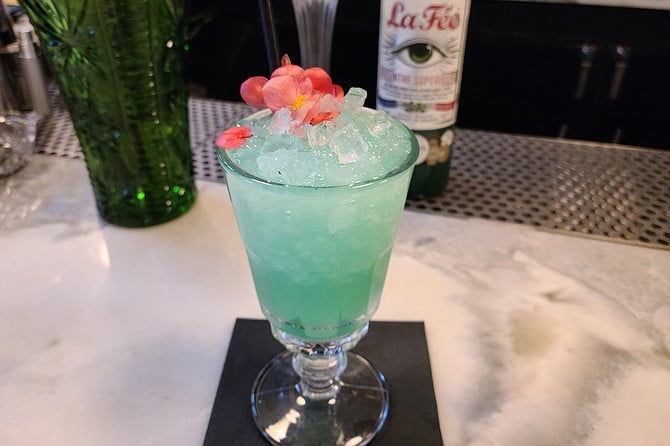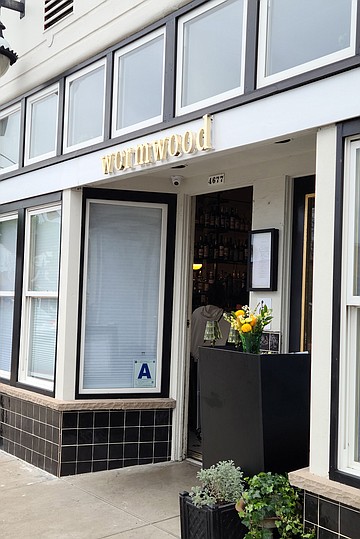 Facebook
Facebook
 X
X
 Instagram
Instagram
 TikTok
TikTok
 Youtube
Youtube


New to the neighborhood, Wormwood introduces itself as an absinthe-focused bar. After greeting me, Ben Marquart busts out a beginner’s lesson on absinthe. He decides Le Frappe is a good place to start. “It’s an absinthe-based cocktail and it also has a little bit of crème de menthe,” he says, noting that these are what give the cocktail its luminous green color. Plus, there’s “a little bit of elderflower, which smooths things out; annisette, which is an anise liqueur; lime juice, which will create acidity; a bit of sugar for balance; and some soda for a tiny bit of effervescence.”
He says that while “it’s not all absinthe, this is the most absinthe-forward cocktail we have. A lot of times, absinthe will be used as a modifier in a cocktail,” he explains as he grabs a pink begonia for garnish. “These guys are super cool! It’s an edible flower, literally tastes like sour apple.”
Et voilà, Le Frappe is served! The cocktail is Wormwood’s “variation of the traditional absinthe frappe, which was created in New Orleans in the late 1800s. When absinthe was just becoming a big thing, with absinthe bars popping up all over New Orleans, this was one of the more refreshing-style cocktails that they were serving at that time. So, it’s an adaptation of that.”
Marquart dispels lingering myths about absinthe. “And then the ban… it was essentially that spirit companies and the wine companies were creating propaganda with absinthe, saying ‘Ah, it makes you go crazy! Hallucinations!’ Things like that. Which is total farce. It is so minute,” he says of the compound found in wormwood. “There’s absolutely no way you could hallucinate from absinthe.”
But it does make for a stiff cocktail. “The alcohol is so high in this spirit; it ranges from 45% to up to 72%. So you want to drip the ice water with a little bit of sugar cube just to dilute, make it a little smoother, make it more palatable.”
Once absinthe became legal in the states, different styles developed. “Some are going to be really dry,” says Marquart. “Some will be very robust… or have almost like bark characteristics, almost like bitters. So the main ingredients will be of the black licorice theme, but there’s the little idiosyncrasies that you can taste with each one by adding water, just to diffuse the harshness and the alcohol of the spirit.” Le Frappe offers a welcome approach to the stuff. “I know absinthe can be somewhat of an acquired taste. This would be a really good starting cocktail for people who want to gain a little more knowledge.”

Pour all ingredients in a shaker tin, add a small scoop of crushed ice, and shake. Pour frappe right into your glass, add a splash of soda water, top with more crushed ice. Garnish with edible pink begonia flowers and enjoy!



New to the neighborhood, Wormwood introduces itself as an absinthe-focused bar. After greeting me, Ben Marquart busts out a beginner’s lesson on absinthe. He decides Le Frappe is a good place to start. “It’s an absinthe-based cocktail and it also has a little bit of crème de menthe,” he says, noting that these are what give the cocktail its luminous green color. Plus, there’s “a little bit of elderflower, which smooths things out; annisette, which is an anise liqueur; lime juice, which will create acidity; a bit of sugar for balance; and some soda for a tiny bit of effervescence.”
He says that while “it’s not all absinthe, this is the most absinthe-forward cocktail we have. A lot of times, absinthe will be used as a modifier in a cocktail,” he explains as he grabs a pink begonia for garnish. “These guys are super cool! It’s an edible flower, literally tastes like sour apple.”
Et voilà, Le Frappe is served! The cocktail is Wormwood’s “variation of the traditional absinthe frappe, which was created in New Orleans in the late 1800s. When absinthe was just becoming a big thing, with absinthe bars popping up all over New Orleans, this was one of the more refreshing-style cocktails that they were serving at that time. So, it’s an adaptation of that.”
Marquart dispels lingering myths about absinthe. “And then the ban… it was essentially that spirit companies and the wine companies were creating propaganda with absinthe, saying ‘Ah, it makes you go crazy! Hallucinations!’ Things like that. Which is total farce. It is so minute,” he says of the compound found in wormwood. “There’s absolutely no way you could hallucinate from absinthe.”
But it does make for a stiff cocktail. “The alcohol is so high in this spirit; it ranges from 45% to up to 72%. So you want to drip the ice water with a little bit of sugar cube just to dilute, make it a little smoother, make it more palatable.”
Once absinthe became legal in the states, different styles developed. “Some are going to be really dry,” says Marquart. “Some will be very robust… or have almost like bark characteristics, almost like bitters. So the main ingredients will be of the black licorice theme, but there’s the little idiosyncrasies that you can taste with each one by adding water, just to diffuse the harshness and the alcohol of the spirit.” Le Frappe offers a welcome approach to the stuff. “I know absinthe can be somewhat of an acquired taste. This would be a really good starting cocktail for people who want to gain a little more knowledge.”

Pour all ingredients in a shaker tin, add a small scoop of crushed ice, and shake. Pour frappe right into your glass, add a splash of soda water, top with more crushed ice. Garnish with edible pink begonia flowers and enjoy!
Comments